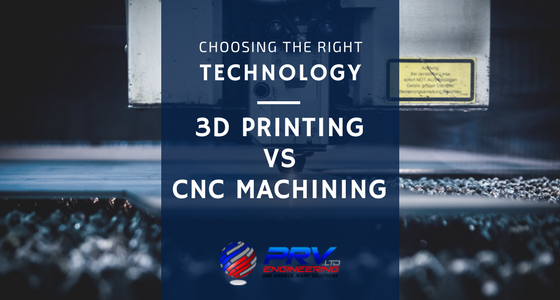Throughout human history there has been, and still is, a number of methods used to manufacture custom parts. Today, modern manufacturing sees 3D printing and CNC machining as the most common ones. In fact, both utilise computer numerical control (CNC), which developed from traditional milling methods after the Second World War.
With the rapid growth of 3D printing technology, many would agree it has become the first choice for a host of industries. On the other hand, CNC machining is still considered a reliable standard and you will not find much nowadays without the involvement of CNC machining somewhere in the manufacturing process.
Considering all the 3D printing and CNC breakthroughs, increased demand for specialised products and skilled engineers, which method is best?
Methodologies
CNC machining is a common subtractive manufacturing technology and unlike 3D printing, the process typically starts with a solid block of material. It then uses a variety of sharp, rotating tools or cutter to achieve the required final shape.
3D Printed objects are made using additive processes where an object is created by laying down successive layers of material until the object is completed. Each of the layers can be seen as a thinly sliced horizontal cross-section of the potential object. Just like with CNC milling machines, a computer feeds the machine specific code that controls the design process.
3D Printing vs CNC Machining
Product development is not a simple process as there are many options for creating models, moulds, prototypes or patterns. Before choosing a technology, one must first understand the project requirements, process considerations and evaluate the resulting time, cost and quality. Without this, it is nigh impossible to identify the optimal process.
Generally, CNC machining is seen as the most popular manufacturing solution for small and medium to high volume production. It builds parts by adding material one layer at a time and doesn’t require special tooling or fixtures resulting in lower setup costs. Not only is it incredibly accurate, it also offers excellent repeatability and a variety of materials and surface finishes.
Although CNC offers better dimensional accuracy and produces parts with better mechanical properties, it usually comes at a greater cost. This is especially the case with small volume projects.
3D printing has been around for a number of years but only recently became a common manufacturing method. Technological innovation and market availability have significantly reduced the cost which and is the simplest way to go from computer-aided design (CAD) to physical part. Production costs are significantly reduced and in most cases, you don’t need to employ skilled machinists.
Not all 3D printing systems are the same and some offer different dimensional accuracy. Industrial machines can produce parts with incredible tolerances and if tight clearances are needed, the dimensions can be 3D printed oversized and then machined during post-processing.
Applications and Materials
Some materials certainly overlap but we’ll focus on a few major ones. CNC mills can work with a large variety of materials such as metal alloys, soft and hardwoods, thermoplastics, acrylic, foams and machining wax. You may need different cutting tools for the different materials but the interface remains the same and the tools are easily interchangeable.
3D printing is somewhat more limited to the likes of thermoplastics and resins. Thermoplastics can be mixed with other materials such as wood, metal and ceramics. Industrial or specialty 3D printers are able to print with more exotic materials.
As far as applications go; CNC is better at manufacturing robust, precise and/or heat-resistant products. In contrast, 3D printing is preferred for quick prototypes, small batches and exotic applications like bio-printing, architectural purposes and food printing.
Guidelines to help you make the right choice
When choosing between CNC Machining and 3D Printing, there are a few simple guidelines to keep in mind. Generally speaking, all parts that can be manufactured with limited effort through a subtractive process should be CNC machined. 3D printing is usually best used in the following instances:
- When traditional methods are unable to produce a part such as a highly complex not able to produce the part, for example for highly complex, structural cross-sections
- Most 3D printed parts can be completed within 24 hours so it’s ideal when a fast turn-around time is required.
- 3D printing is generally cheaper than CNC for small volumes which makes it a good option when low-cost is essential.
- When there is a small number of identical parts required (less than 10).
- When specialised materials are needed but cannot be easily machined. Examples include metal superalloys or flexible TPU filament.
The truth is, both technologies have their place in the manufacturing industry. Where one technology falters, the other excels. Keep in mind when designing your product that using both technologies during product development might be the best solution after all. Together they can truly improve the design and manufacturing process.
CNC is still the preferred method for end-use metal parts as only very expensive laser sintering machines can create similar parts in a 3D printing method. However, 3D printers can be used to generate iterations before a product is sent to an expensive machinist.
What are your thoughts on these two manufacturing methods? Which have you used and how would you describe your experiences? Our expertise extends into a number of industries such as automotive, rail, construction, aerospace and defence. Please get in touch if you need assistance with any of your projects.


Recent Comments